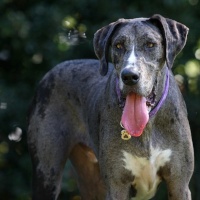Appearance of the English Bull Dane
|
| The English Bull Dane is most likely to take on the general height of the Great Dane. Due to the lack of official breed standards, its appearance may inherit the dominant traits of either the Bulldog or the Great Dane. Generally, the face may resemble the Bulldog but with a slightly longer muzzle. Its strong, athletic build can be attributed to the structure of the Great Dane. Its coat varies in color and can inherit white, black and brown with occasional patches. Eyes are generally light or dark brown. Their parallel legs are straight and powerful. Their giant legs are also inherited from the Great Dane. The tail is fine, short-haired and hangs directly over the body. |
Temperament of the English Bull Dane
|
| The English Bull Dane is a gentle, down-to-earth breed that wants to please its family. This discreet dog prefers to spend the day with you rather than hunting. Its voice is occasional, and it's not a nuisance. Whereas the Great Dane is not good with newcomers, the English Bull Dane loves and accepts new people. It welcomes young children and other pets as a friendly breed. Their moderate energy levels mean they are less likely to engage in property destruction if left alone for a few hours. Although this loyal breed accepts new people, it's still possible for him to be wary of others. Early training and socialization are recommended to prevent any potential aggression. Positive reinforcement is recommended to ensure his safety in his environment. His calm, responsive nature makes him a wonderful companion. |
Needs and activities of the English Bull Dane
|
| Your English Bull Dane has moderate energy levels that will require meeting daily exercise requirements. He will benefit from fetching, walking and running to ensure he stays healthy. Around two walks a day are recommended to ensure he meets his minimum requirements. Since your adorable dog isn't considered the most active, he'd be more than happy to accompany you to your sofa for a lazy day. Apartment life is acceptable as long as he can exercise outdoors to enrich his mind. Your English Bull Dane would do best in an urban home with a fenced-in yard and a warm climate. |
Maintenance of the English Bull Dane
|
| The English Bull Dane is not considered a hypoallergenic hybrid breed and sheds moderately. Daily brushing for 10 to 15 minutes with a curry rubber brush will suffice to remove dead hairs. Bathing should be limited to every 6 to 8 weeks to avoid overproduction of oils in the skin. Ears should be wiped and cleaned weekly to avoid earwax debris. Teeth should be brushed daily to prevent tartar build-up. Nails should be trimmed or filed every 2 to 3 weeks. This breed is known to drool and may have a moderate odor on the skin. |









 English (United Kingdom)
English (United Kingdom)